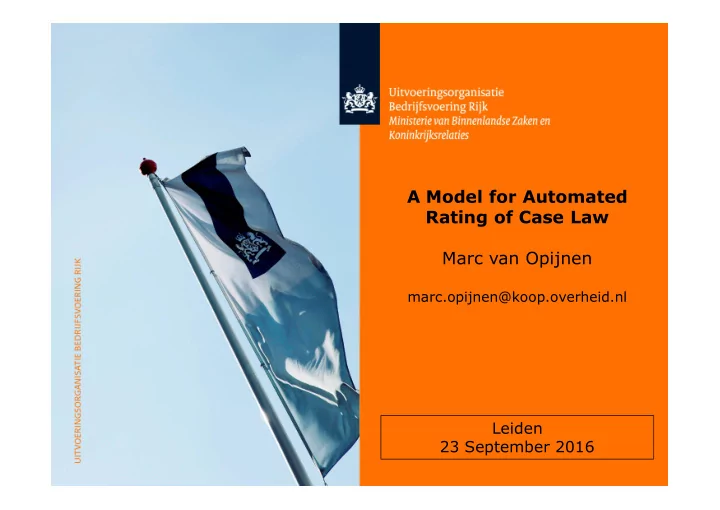

1 11-11- 2015 A Model for Automated Rating of Case Law Marc van Opijnen marc.opijnen@koop.overheid.nl Leiden 23 September 2016
Marc van Opijnen
Topics • Relevance and legal importance • A Model for Automated Rating of Case Law: – Basic ideas – Gathering network data – A brief outline of MARC. 3
Relevance • One only wants the most relevant documents • But what is ‘relevant’? • “Relation to the matter at hand” – Contextual dependency – Comparative concept – Human concept, and hence a little messy.
Relevance in Legal Information Retrieval • Algorithmic relevance • Topical relevance: – Isness – Aboutness • Cognitive relevance (search task at hand) • Situational relevance (work task at hand) • Domain relevance, e.g: – Legal hierarchy within legislation – Legal importance within case law repositories. (van Opijnen & Santos 2016)
How to Measure Legal Importance? • A small forum of specialists? – Too much work – Continuous updating – Too much disagreement • The whole legal crowd – Every expert’s decision to publish, annotate or cite – Network analysis as a starting point – (but that’s not enough).
Collection of data • Big data and network analysis: how more data, how better the analysis • 850.000 judicial decisions • 560.000 files with legal doctrine • Metadata: – Publication on Rechtspraak.nl and in periodicals – Annotations in periodicals – Type of court – Age – Number of judges – Length • Citations: – 412.000 case law cross-references – 673.000 case law citations in legal doctrine – 5.569.000 citations to (particles of) legislation.
The Problem of Legal References • References usually not available in metadata • In text only = not computer readable • Wide variety of identifiers, formats and aliases: Directive 2006/123/EC – Dir. (EU) 2006-123 – Services directive – Bolkestein directive – “ … hereinafter: ‘the Directive’ … ” – Οδηγια 2006/123/ΕΚ – • Impossible for a search engine • Detect the links before you index and search: LinkeXtractor. (van Opijnen, Verwer & Meijer 2015)
Legal References
Regression statistics Predictors Regressor Gender Disease X Age Calculate the probability Previous of disease X, considering diseases the value of the predictors. Environmental factors General condition
Publication Period Transition Period Citation Period Character Judgment sees the light of Study and comments Fame or oblivion day Duration One week Three months Infinite Regressor Publication except judiciary Weighted average of: Citation in case law and website one-off legal literature in • MARC publication period coming three years • MARC citation period Predictors • Outgoing case law • Publication (weighted) citations Depending on the day within • Annotations (ibidem) transition period. • Outgoing legislation citations • Citations in continuous literature (logaritmic) • Unus iudex / full court • Citations in one-off • Length literature (log.+ weighted moving average) • Publication on judiciary website • Citation in case law (ibidem) • Press release on judiciary website • Age • Type of court • Type of court • Field of law • Field of law
Simplifying the model • Values range from -0,4894170847 to 32,663963198 • Group them in five classes: MARC-1 to MARC-5 • Where to set the boundaries between the classes? – Depends on the contents of the database, – And is a subjective task.
Comparing MARC for Publication Period and Citation Period Publication period Citation 1 2 3 4 5 Total period 1 71,1 0,1 0,0 0,0 0,0 71,2 2 3,9 11,1 0,9 0,0 0,0 15,8 3 0,0 4,8 4,8 1,2 0,0 10,9 4 0,0 0,5 0,7 0,4 0,2 1,7 5 0,0 0,0 0,1 0,1 0,1 0,3 Total 75,0 16,5 6,5 1,7 0,3 100,0 87,5% in same class; 11,9% deviates one class; 0,6% two classes.
Future work • More data • Improved data • More variables – Results of appeal (quashings more important than upholdings) – Granular topics • Implementation.
Thank you
Recommend
More recommend